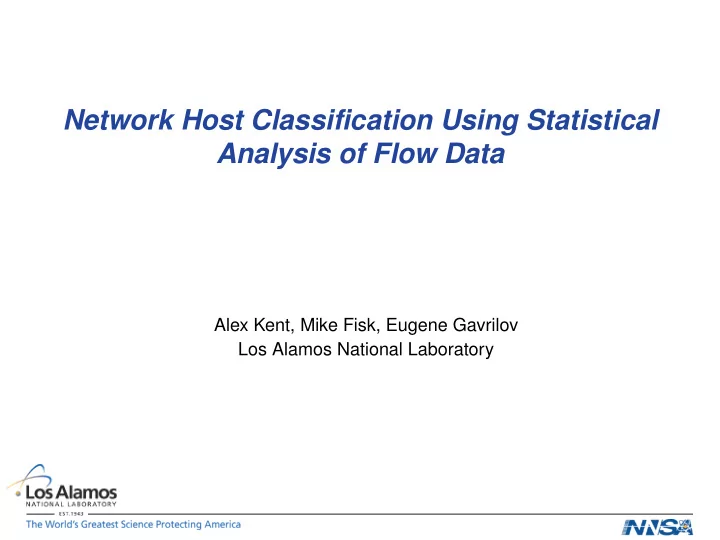

Network Host Classification Using Statistical Analysis of Flow Data Alex Kent, Mike Fisk, Eugene Gavrilov Los Alamos National Laboratory
Overview and Objectives Host/IP address profiling based on flow data over some time interval • 10 minutes to 7 days have been examined with 24 hours providing repetitively stationary results • Generate histograms of peer hosts, source ports, and destination ports over the time interval • Compute Shannon entropy values for the 3 dimensions Outcomes: • Provide IP behavior “snapshots” of individual hosts • Allow comparison of behavior through clustering • Build models over large host sets in real-time
Source / Destination Port Variance Does not provide an effective representation of categorical data sets
Sample (simplified) Histogram of Flow Data Host A Cumulative bytes Cumulative packets Cumulative sessions Peer A 34958 324 54 3948 132 13 Peer B Peer C 231 43 9 Peer D 5675 123 29 Src Port 1 2358 77 32 Src Port 2 13246 345 67 Src Port 3 1231 75 12 Dst Port 1 54467 5653 199 Dst Port 2 563 345 1 Host B Peer X 842 347 23 Peer Y 23879 3452 874 Peer Z 9463 232 78 ... ... ... ... ...
Shannon Entropy Using Packet Count Histograms where Computed for host peers, source ports, and destination ports time-delineated histograms leveraging byte, packet, and session totals • Packet histograms/entropy calculation favored in final analysis • Since base 2: port entropy will be 0-16, peer 0-32 (IPv4)
Sample Entropy Calculation For Host A: Cumulative packets Pi Packets Pi * log2( Pi ) Entropy Peer A 324 0.52 -0.49 Peer B 132 0.21 -0.47 Peer C 43 0.07 -0.27 Peer D 123 0.20 -0.46 1.69 Src Port 1 77 0.15 -0.42 Src Port 2 345 0.69 -0.37 Src Port 3 75 0.15 -0.41 1.19 Dst Port 1 5653 0.94 -0.08 Dst Port 2 345 0.06 -0.24 0.32
Visual Example of Low/High Entropy Low Entropy Example High Entropy Example
Data Overview Uses generic flow data • Required fields: – SRC IP, DST IP, SRC Port, DST Port, Protocol, Packets, Bytes Los Alamos unclassified network primarily over 24 hours (inclusive of a work day) • Approximately 200 million flows analyzed • 17,326 unique internal (Los Alamos) IP’s observed • Day-to-day traffic very consistent
Destination Port / Peer Entropy Peer Host Entropy Destination Port Entropy
Source Port / Peer Entropy Peer Host Entropy Source Port Entropy
Source Port / Destination Port Entropy Destination Port Entropy Source Port Entropy
Source/Destination Port Entropy Clustering Destination Port Entropy Source Port Entropy
Entropy Clustering w/ 3 Dimensions Destination Port Entropy Source Port Entropy
Interesting Clusters (<50) 749 Hosts (4.3% of total) Destination Port Entropy Source Port Entropy
Interesting Clusters (b) Source port versus Peers Peer Host Entropy Source Port Entropy
Major Servers Host Local Port EntRemote Port EntPeer Ent Cluster SMS 1 1.04 11.61 11.78 42 SMS 2 1.13 11.67 11.82 42 Int W W W 1.24 11.97 11.49 42 ActiveDir 1 2.7 11.52 11.96 42 ActiveDir 2 4.41 10.09 9.98 46 ActiveDir 3 2.86 10.62 10.56 46 DNS 1 1.76 9.76 9.11 5 DNS 2 0.74 12.5 9.99 13 VulnScanner 12.08 8.62 8.99 8 MailRelay 1 7.4 5.12 4.31 36 MailRelay 2 7.42 5.05 4.29 36 MailRelay 3 7.58 5.13 4.45 36
Clusters C32 & C56 Bad Behavior (worm variants) Host IP Local Port EntRemote Port EntPeer Ent Remote Host A 11.45 0.79 11.89 Remote Host B 10.18 1.06 9.84 Internal Host A 10.32 1.26 9.87 Internal Host B 10.89 0.79 11.01 Remote Host C 10.83 1.77 10.46 Remote Host D 11.71 0.45 13.67 Remote Host E 11.04 0.65 10.8 Remote Host F 11.93 0.15 15.72
Current, On-going Work Demonstrated 1 million+ flows/minute processing on single system • Redesigning, porting system to map/reduce architecture for improved scaling and distributed processing Integrating additional network flow data types (e.g. custom perimeter collected flows) Static centroids for comparing host movements between k-means clusters • Enable predefined clusters, cluster definitions, and host movement between clusters Histogram merging that allows graceful data aging for continuous data feed and anomaly detection Application of novel change detection and machine learning across time series output
Recommend
More recommend